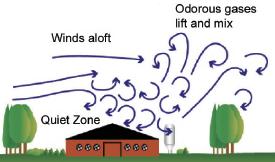
2 minute read
DETERMINE YOUR GOALS
SECTION 02
DETERMINE YOUR GOALS
Advertisement
Get the most out of your vegetative buffers. Your goals can address a number of issues that will not only enhance neighborhood relations but also make your site more functional, efficient, a better place to raise your livestock and a better place to work. See page 31 for a worksheet to help you list your goals and site inventory. Some goals that vegetative buffers can address are:
ANIMAL HEALTH
A well-designed landscape will contribute to the overall health of the livestock by keeping them cooler in summer and warmer in winter.
ODOR REDUCTION
Vegetative buffers can help change wind patterns to redirect odors higher in the air for better dilution and can create dead air pockets so the particles can drop to the ground or onto the plant material.
ENERGY EFFICIENCY
Often livestock barns are located on an open landscape away from residences. Because of this, harsh winter winds can have a huge impact on the comfort for the people who work there and the livestock they are caring for. Windbreaks will block those harsh winds. In an ideal situation well-designed windbreaks can reduce energy costs by as much as 25 percent.

NRCS: WINDBREAK/SHELTERBELT ESTABLISHMENT
SECTION 02
Strategically placed shade (large deciduous) trees can shade the buildings and reduce heat build up. Trees act as nature’s air conditioners. A mature shade tree can block up to 90 percent of solar radiation, which could translate to a significant reduction in cooling costs. Air temperatures under a shaded condition are typically 15 to 20 degrees cooler than non-shaded areas. In the summer this means more comfort for both people and livestock.
Planting native grasses and wildflowers can minimize the time spent mowing and reduce fuel costs.
SNOW MANAGEMENT
Properly designed windbreaks and native grass and wildflower plantings can help farmers control snow drifting around buildings and driveways.
WILDLIFE
Wildlife habitat is increasingly scarce as we farm bigger fields with fewer fence rows. Evergreen trees, shade and flowering trees, shrubs, native grasses and wildflowers provide habitat for game and song birds, small animals, and pollinating bees and insects that perform valuable functions in any landscape, not to mention their contribution to our emotional well-being.
AESTHETICS
Having a good-looking, well-maintained farmstead and/or livestock operation contributes positively to good neighborhood relations and the total rural landscape scene. Using a combination of evergreens, deciduous shade and flower trees and shrubs, native grasses and wildflowers can contribute seasonal color throughout the year.
WATER QUALITY + STORM WATER MANAGEMENT
Planting trees and shrubs and using filter strips of fibrous, deep-rooted vegetation will filter out nutrients from surface water and allow infiltration into underground aquifers.





